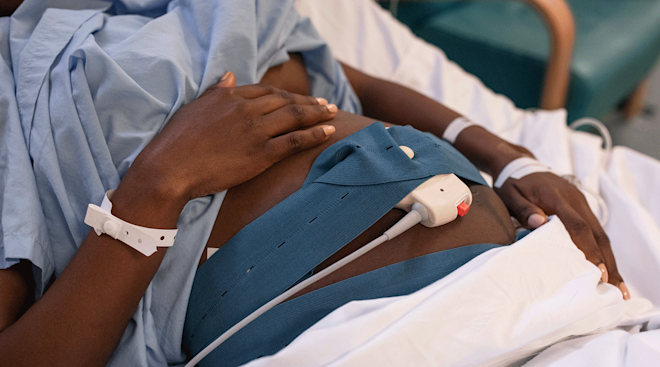What Is Active Labor?
The movies lie. The truth is: Most women don’t go into labor instantaneously with things kicking into high gear at a rapid-fire pace. In fact, there are a few progressive stages of labor to anticipate. While everyone’s experience is unique, these stages and phases help you and care your team know what to expect throughout your specific laboring journey. And once you officially hit the active labor phase, things really start happening.
Knowing how to identify that you’re in active labor can help you get some grasp what’s going on with your body, says Sarah Kent, CNM, a nurse midwife at Corewell Health in Grand Rapids, Michigan. “Everyone’s labor experience will unfold in its own way, but many women find it helpful to have a general understanding of what to anticipate once labor begins,” she says.
So what is active labor, and how can you know if you’re in the throes of it? Read on to learn the signs of active labor, how long this phase will generally last and what you might be feeling (spoiler alert: the contractions will get stronger and more frequent).
Labor is generally broken into three stages, with various phases within them. The first stage features three important phases: early (or latent), active and transitional. As the name implies, early labor is the start of labor. During this time, your cervix will soften, shorten in length and dilate, Kent says. “Contractions may be irregular in timing and duration,” adds Damali Campbell Oparaji, MD, and ob-gyn and associate professor at Rutgers New Jersey Medical School.
In active labor, contractions become more regular, Kent says. During the transitional phase—which is considered part of active labor—contractions are longer and closer together.
During the second stage of labor, baby crowns and you push. The third stage of labor involves delivery of the placenta.
Active labor is when your cervix dilates to 6 centimeters and you experience regular, more intense contractions), Kent says. (Up until that point they may have come and gone.) According to the American College of Obstetricians and Gynecologists (ACOG), the rate that your cervix dilates “significantly increases” in active labor.
If your water hasn’t already broken, it usually does during active labor, Kent says. And, BTW, if you suspect you’re in active labor, it’s time to go to the hospital (or another designated birthing place) if you haven’t yet.
There are a few different things that can cue that you’re in active labor. While Campbell Oparaji says it varies from person to person, the following can be signs of active labor:
- Contractions speed up. “Generally contractions are more frequent—every two to three minutes, lasting about one minute,” Campbell Oparaji says.
- Contractions are more intense. While you may have felt just fine walking around and going about your usual life during early labor, it can be harder to get comfortable during active labor, Campbell Oparaji says. “Some women report feeling the intensity of their contractions in their lower back and wrapping around to the front of their abdomen,” Kent says.
- Contractions are more predictable. Campbell Oparaji says that contractions tend to be “more regular in timing” during the active phase.
- You have new discharge. “In active labor, you often experience bloody vaginal discharge, which is caused from your cervix dilating,” Kent says.
When you progress to the transition phase of active labor, contractions get stronger, Kent says. “Some women experience nausea and vomiting and the ‘labor shakes’ during this time,” she adds.
When active labor starts “varies from person to person,” Campbell Oparaji says. If this is your first pregnancy, you may reach the active phase of labor 18 to 24 hours after your labor started, she says. But in subsequent pregnancies, she says it’s usually shorter. If you need to be induced, it can take up to 72 hours to reach the active phase of labor, Campbell Oparaji says.
Your healthcare team will determine that you’ve transitioned to active labor when you’re 6 centimeters dilated, Campbell Oparaji says. Older criteria had active labor start at 4 centimeters dilated, but newer research “observes that closer to 6 may be more accurate,” Campbell Oparaji notes.
Every woman is different, but Kent says that it’s “very normal” for active labor to last four to eight hours. Still, labor is unique for every person, meaning, it can be tough to know exactly how long active labor will last for you.
There are a few factors that tell that you’ve transitioned to the next phase of labor, including how dilated you are, Campbell Oparaji says. “The care team will generally determine [if you’ve transitioned] by frequency and intensity of contractions, along with cervical dilatation,” she says.
But the transition phase of labor is usually when contractions are “quite intense,” Campbell Oparaji says. “Some women who get epidural anesthesia may not experience severe uterine contractions, but experience pressure sensations that aren’t always relieved with an epidural,” she says.
The good news? Once you’ve hit this phase, you’re getting much closer to meeting baby face-to-face. “When your cervix has fully dilated and you begin pushing, you’re now in the next stage, or second stage of labor which involves pushing with your contractions and the birth of baby,” Kent says.
There’s a lot to keep in mind when it comes to active labor, and it can be tough to wrap your head around all of it, especially in the heat of the moment. While your provider should keep you posted on your progress, it’s more than okay to ask questions about where you’re at in the process and what happens next.
Please note: The Bump and the materials and information it contains are not intended to, and do not constitute, medical or other health advice or diagnosis and should not be used as such. You should always consult with a qualified physician or health professional about your specific circumstances.
Plus, more from The Bump:
Sarah Kent, CNM, is a nurse-midwife at Corewell Health in Grand Rapids, Michigan. She earned her master of science in nursing from Frontier School of Midwifery & Family Nursing in Hyden, Kentucky.
Damali Campbell Oparaji, MD, is and ob-gyn and associate professor at Rutgers New Jersey Medical School. She earned her medical degree from Temple University School of Medicine in Philadelphia.
American College of Obstetricians and Gynecologist (ACOG), Safe Prevention of the Primary Cesarean Delivery, March 2014
American Journal of Obstetrics and Gynecology (AJOG), 6cm is the new 4cm: evaluating the definition of active phase of labor and its potential effect on cesarean rates and mortality, January 2014
Learn how we ensure the accuracy of our content through our editorial and medical review process.
Navigate forward to interact with the calendar and select a date. Press the question mark key to get the keyboard shortcuts for changing dates.




















































